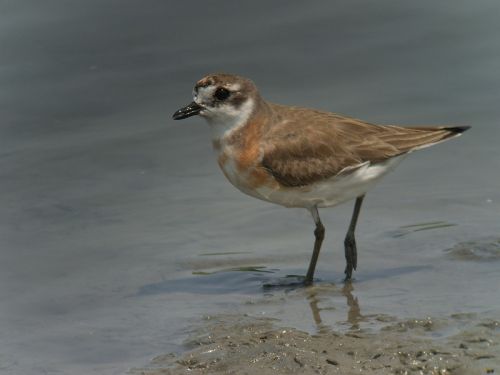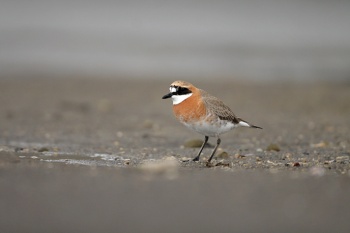Aloktewari (talk | contribs) (Ssp. ''C. m. pamirensis'' image added) |
(→External Links: improved GSearch; VSearch added) |
||
| (13 intermediate revisions by 5 users not shown) | |||
| Line 1: | Line 1: | ||
| − | + | [[Image:Mongolian_Plover.jpg|thumb|500px|right|Photo © by {{user|Akiko+Hidaka|Akiko Hidaka}} <br /> Tokyo, [[Japan]], August]] | |
| − | [[Image:Mongolian_Plover.jpg|thumb| | + | '''Alternative name: Siberian Plover. The name Mongolian Plover was sometimes used for what became this species but also sometimes for other combinations of subspecies.''' |
| − | ;[[:Category: | + | |
| + | ;[[Category:Anarhynchus]] [[:Category:Anarhynchus|Anarhynchus]] mongolus | ||
| + | ''Charadrius mongolus'' | ||
==Identification== | ==Identification== | ||
| + | [[Image:Gravelot mongol 070507-3240.jpg|thumb|350px|right|Breeding plumage<br />Photo © by {{user|Francksan|Francksan}}<br />Hokkaido, [[Japan]], May 2007 ]] | ||
18–21 cm (7-8¼ in) | 18–21 cm (7-8¼ in) | ||
| − | * | + | *back brownish grey |
| − | * | + | *underparts white |
| − | * | + | *flanks mottled |
| + | *legs dark | ||
| + | *bill black | ||
'''Breeding''' | '''Breeding''' | ||
| − | * | + | *breast, forehead and nape chestnut |
| − | * | + | *eye mask black |
| + | *front white surrounded by black which is fused with eye mask | ||
The female is similar but duller<br /> | The female is similar but duller<br /> | ||
'''Winter and juvenile''' birds lack the chestnut | '''Winter and juvenile''' birds lack the chestnut | ||
| − | + | ====Similar species==== | |
| − | + | Siberian Sand Plover differ from Tibetan Sand Plover in: | |
| + | *Siberian average larger, bill thicker and end blunter, legs shorter | ||
| + | *flanks are mottled in Siberian but clean in Tibetan | ||
| + | *in flight: feet protrudes past tail on Tibetan but usually not on Siberian | ||
| + | In breeding plumage | ||
| + | *Siberian male usually have some white above bill in the "bandits mask" while this is rare in Tibetan | ||
| + | *female Tibetan rarely have black in auricular area, something usually found in Siberian. | ||
| + | In non-breeding plumage | ||
| + | *breast band (nearly) unbroken on Siberian, but limited to breast sides in Tibetan | ||
| + | *pale forehead grades into the crown in Tibetan while demarcation is sharp in Siberian | ||
| + | Compare also with [[Greater Sand Plover]] | ||
====Similar Species==== | ====Similar Species==== | ||
| + | [[Image:Lesser Sandplover 3-1.jpg|thumb|350px|right|Photo © by {{user|Ken+Doy|Ken Doy}}<br />Wellington Point, Brisbane, [[Queensland]], [[Australia]], March 2020]] | ||
[[Greater Sand Plover]] | [[Greater Sand Plover]] | ||
==Distribution== | ==Distribution== | ||
| − | + | Is only known to breed within [[Siberia]] (the eastern third, also known as [[Far East Russia]]. It winters in east [[Asia]] from southern [[Japan]] and along the eastern coast of [[China} to [[Greater Sundas]], [[New Guinea]], [[Australia]], and in small numbers to [[New Zealand]].<br /> | |
| − | Vagrants have been recorded in [[Europe]] and [[America]]. | + | Vagrants have been recorded in [[Europe]], [[North America]], and [[South America]]; however, [[Alaska]] is likely regularly visited during migration. |
==Taxonomy== | ==Taxonomy== | ||
| + | This species and [[Tibetan Sand Plover]] were formerly lumped under the name of Lesser Sand Plover (sometimes instead named Mongolian (Sand) Plover). | ||
| + | |||
====Subspecies==== | ====Subspecies==== | ||
| − | + | Clements recognises the following subspecies [[#References|[1]]]: | |
| − | + | *''A. m. mongolus'': Eastern [[Siberia]] and [[Russia|Russian Far East]]; winters [[Taiwan]] to [[Australia]] | |
| − | + | *''A. m. stegmanni'': Kamchatka to Chukotsk Peninsula; winters to [[Australia]] | |
| − | |||
| − | |||
| − | |||
| − | |||
| − | |||
| − | |||
| − | |||
| − | *'' | ||
| − | |||
| − | *'' | ||
| − | |||
==Habitat== | ==Habitat== | ||
| − | |||
Coastal shores, mudflats and fields | Coastal shores, mudflats and fields | ||
==Behaviour== | ==Behaviour== | ||
| + | Strongly migratory, however, birds in their second calendar year may stay in the wintering grounds. | ||
====Breeding==== | ====Breeding==== | ||
| − | + | They nest in a bare ground scrape; the clutch consists of 3 eggs. | |
====Diet==== | ====Diet==== | ||
| − | + | Their varied diet includes insects, crustaceans, such as crabs and molluscs and annelid worms on their non-breeding grounds. What they eat during the breeding season is not well recorded. | |
====Vocalisation==== | ====Vocalisation==== | ||
'''Flight call''': A hard trill. | '''Flight call''': A hard trill. | ||
==References== | ==References== | ||
| − | + | #{{Ref-Clements6thOct23}}#{{Ref-GillDonskerRasmussen22V14.1}}#Collins Bird Guide ISBN 0 00 219728 6 | |
| − | #{{Ref- | ||
| − | |||
#[http://www.birdforum.net/showthread.php?t=151101 Thread] in Birdforum Id forum discussing Lesser vs Greater Sand Plover identification | #[http://www.birdforum.net/showthread.php?t=151101 Thread] in Birdforum Id forum discussing Lesser vs Greater Sand Plover identification | ||
| + | #Wiersma, P., Kirwan, G.M., Christie, D.A. & Boesman, P. (2020). Lesser Sandplover (Charadrius mongolus). In: del Hoyo, J., Elliott, A., Sargatal, J., Christie, D.A. & de Juana, E. (eds.). Handbook of the Birds of the World Alive. Lynx Edicions, Barcelona. (retrieved from https://www.hbw.com/node/53845 on 3 March 2020) | ||
{{ref}} | {{ref}} | ||
==External Links== | ==External Links== | ||
| − | {{GSearch|Charadrius | + | {{GSearch|"Anarhynchus mongolus" {{!}} "Siberian Sand Plover" {{!}} "Siberian Sandplover"}} |
| + | <br /> | ||
| + | {{VSearch|"Anarhynchus mongolus" {{!}} "Siberian Sand Plover" {{!}} "Siberian Sandplover"}} | ||
| + | |||
| + | <br /> | ||
| + | '''Warning: the following two searches are likely to find a lot of birds that were uploaded as "Lesser Sand Plover and may include some that really belong to [[Tibetan Sand Plover]]''' | ||
| + | {{GSearch|"Anarhynchus mongolus" {{!}} "Charadrius mongolus" {{!}} "Siberian Sand Plover" {{!}} "Siberian Sandplover" {{!}} "Mongolian Plover" {{!}} "Mongolian Dotterel" {{!}} "Mongolian Sand Plover" {{!}} "Mongolian Sandplover"}} | ||
| + | <br /> | ||
| + | {{VSearch|"Anarhynchus mongolus" {{!}} "Charadrius mongolus" {{!}} "Siberian Sand Plover" {{!}} "Siberian Sandplover" {{!}} "Mongolian Plover" {{!}} "Mongolian Dotterel" {{!}} "Mongolian Sand Plover" {{!}} "Mongolian Sandplover"}} | ||
| + | |||
| + | {{GS-checked}}1 | ||
| + | <br /> | ||
<br /> | <br /> | ||
| − | |||
| − | [[Category: | + | [[Category:Anarhynchus]][[Category:Birds]] |
Latest revision as of 16:05, 30 December 2023
Alternative name: Siberian Plover. The name Mongolian Plover was sometimes used for what became this species but also sometimes for other combinations of subspecies.
- Anarhynchus mongolus
Charadrius mongolus
Identification
18–21 cm (7-8¼ in)
- back brownish grey
- underparts white
- flanks mottled
- legs dark
- bill black
Breeding
- breast, forehead and nape chestnut
- eye mask black
- front white surrounded by black which is fused with eye mask
The female is similar but duller
Winter and juvenile birds lack the chestnut
Similar species
Siberian Sand Plover differ from Tibetan Sand Plover in:
- Siberian average larger, bill thicker and end blunter, legs shorter
- flanks are mottled in Siberian but clean in Tibetan
- in flight: feet protrudes past tail on Tibetan but usually not on Siberian
In breeding plumage
- Siberian male usually have some white above bill in the "bandits mask" while this is rare in Tibetan
- female Tibetan rarely have black in auricular area, something usually found in Siberian.
In non-breeding plumage
- breast band (nearly) unbroken on Siberian, but limited to breast sides in Tibetan
- pale forehead grades into the crown in Tibetan while demarcation is sharp in Siberian
Compare also with Greater Sand Plover
Similar Species
Distribution
Is only known to breed within Siberia (the eastern third, also known as Far East Russia. It winters in east Asia from southern Japan and along the eastern coast of [[China} to Greater Sundas, New Guinea, Australia, and in small numbers to New Zealand.
Vagrants have been recorded in Europe, North America, and South America; however, Alaska is likely regularly visited during migration.
Taxonomy
This species and Tibetan Sand Plover were formerly lumped under the name of Lesser Sand Plover (sometimes instead named Mongolian (Sand) Plover).
Subspecies
Clements recognises the following subspecies [1]:
- A. m. mongolus: Eastern Siberia and Russian Far East; winters Taiwan to Australia
- A. m. stegmanni: Kamchatka to Chukotsk Peninsula; winters to Australia
Habitat
Coastal shores, mudflats and fields
Behaviour
Strongly migratory, however, birds in their second calendar year may stay in the wintering grounds.
Breeding
They nest in a bare ground scrape; the clutch consists of 3 eggs.
Diet
Their varied diet includes insects, crustaceans, such as crabs and molluscs and annelid worms on their non-breeding grounds. What they eat during the breeding season is not well recorded.
Vocalisation
Flight call: A hard trill.
References
- Clements, J. F., P. C. Rasmussen, T. S. Schulenberg, M. J. Iliff, T. A. Fredericks, J. A. Gerbracht, D. Lepage, A. Spencer, S. M. Billerman, B. L. Sullivan, and C. L. Wood. 2023. The eBird/Clements checklist of Birds of the World: v2023. Downloaded from https://www.birds.cornell.edu/clementschecklist/download/
- Gill, F, D Donsker, and P Rasmussen (Eds). 2024. IOC World Bird List (v 14.1). Doi 10.14344/IOC.ML.14.1. http://www.worldbirdnames.org/
- Collins Bird Guide ISBN 0 00 219728 6
- Thread in Birdforum Id forum discussing Lesser vs Greater Sand Plover identification
- Wiersma, P., Kirwan, G.M., Christie, D.A. & Boesman, P. (2020). Lesser Sandplover (Charadrius mongolus). In: del Hoyo, J., Elliott, A., Sargatal, J., Christie, D.A. & de Juana, E. (eds.). Handbook of the Birds of the World Alive. Lynx Edicions, Barcelona. (retrieved from https://www.hbw.com/node/53845 on 3 March 2020)
Recommended Citation
- BirdForum Opus contributors. (2024) Siberian Sand Plover. In: BirdForum, the forum for wild birds and birding. Retrieved 29 April 2024 from https://www.birdforum.net/opus/Siberian_Sand_Plover
External Links
Warning: the following two searches are likely to find a lot of birds that were uploaded as "Lesser Sand Plover and may include some that really belong to Tibetan Sand Plover
GSearch checked for 2020 platform.1






